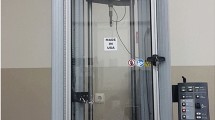Abstract
The present work examines the effects of hygrothermal and UV radiation aging on the reinforced epoxy composites. The role of temperature in the hygrothermal aging process on tensile properties, impact behavior of composites and compression-after impact was investigated. Among four different chosen aging conditions, three of them were hygrothermal and last one was composed of both hygrothermal and UV radiation. Unidirectional e-glass fiber fabrics with an areal density 300 g/m2 as reinforcement and epoxy matrix were used. Composites were manufactured using vacuum-assisted resin infusion molding. The goal of this study was to investigate the effect of UV radiation and aging temperature with respect to the glass transition temperature. In this context, aging procedures were carried out in two different ways for 70 °C temperature with and without UV radiation. As a result of the test, the tensile strength, tensile modulus, absorbed energy, interlaminar shear strength (ILSS), and compression-after impact (CAI) strength of the glass reinforced composites decreased for all conditions. Despite being under the same ambient temperature and humidity, the samples which were exposed to UV radiation had lower mechanical properties. The reduction of tensile strength of specimens exposed to 70 °C and 70% humidity with and without UV radiation were 24% and 10%, respectively. The temperature of hygrothermal conditions significantly affected the perforation threshold. In low impact energies, delamination was the primary damage mode, while fiber breakage becomes more important in the composite at high impact energy levels.







Similar content being viewed by others
References
Carra G, Carvelli V (2014) Ageing of pultruded glass fibre reinforced polymer composites exposed to combined environmental agents. Compos Struct 108:1019–1026
Kumar BG, Singh RP, Nakamura T (2002) Degradation of carbon fiber-reinforced epoxy composites by ultraviolet radiation and condensation. J Compos Mater 36:2713–2733
Ray BC (2006) Temperature effect during humid ageing on interfaces of glass and carbon fibers reinforced epoxy composites. J Colloid Interf Sci 298:111–117
Fiore V, Scalici T, Sarasini F, Tirilló J, Calabrese L (2017) Salt-fog spray aging of jute-basalt reinforced hybrid structures: flexural and low velocity impact response. Compos Part B Eng 116:99–112
Vieille B, Aucher J, Taleb L (2012) Comparative study on the behavior of woven-ply reinforced thermoplastic or thermosetting laminates under severe environmental conditions. Mater Des 35:707–719
Deroiné M, Le Duigou A, Corre Y-M, Le Gac P-Y, Davies P, César G, Bruzaud S (2014) Accelerated ageing of polylactide in aqueous environments: comparative study between distilled water and seawater. Polym Degrad Stab 108:319–329
Karbhari VM, Xian G (2009) Hygrothermal effects on high V F pultruded unidirectional carbon/epoxy composites: moisture uptake. Compos Part B Eng 40:41–49
Zhong Y, Joshi SC (2015) Impact behavior and damage characteristics of hygrothermally conditioned carbon epoxy composite laminates. Mater Des 65:254–264
Ahmad F, Hong J-W, Choi HS, Park MK (2016) Hygro effects on the low-velocity impact behavior of unidirectional CFRP composite plates for aircraft applications. Compos Struct 135:276–285
Park SY, Choi WJ, Choi HS (2010) The effects of void contents on the long-term hygrothermal behaviors of glass/epoxy and GLARE laminates. Compos Struct 92:18–24
Jana RN, Bhunia H (2010) Accelerated hygrothermal and UV aging of thermoplastic polyurethanes. High Perform Polym 22:3–15
Wang HY, Liu YW, Sun B, Huang SJ, Tian JF (2013) Aging behavior of the polyether polyurethane films irradiated by UV. Adv Mater Res 748:16–21
Nicholas J, Mohamed M, Dhaliwal GS, Anandan S, Chandrashekhara K (2016) Effects of accelerated environmental aging on glass fiber reinforced thermoset polyurethane composites. Compos Part B Eng 94:370–378
Icten BM, Atas C, Aktas M, Karakuzu R (2009) Low temperature effect on impact response of quasi-isotropic glass/epoxy laminated plates. Compos Struct 91:318–323
Aktaş M, Karakuzu R, Arman Y (2009) Compression-after impact behavior of laminated composite plates subjected to low velocity impact in high temperatures. Compos Struct 89:77–82
Natsuki T, Yoshizawa K, Bao LM, Ni QQ (2017) Theoretical analysis of low-velocity impact response in two-layer laminated plates with an elastic medium layer. Compos Struct 162:308–312
Ravandi M, Teo WS, Tran LQN, Yong MS, Tay TE (2017) Low velocity impact performance of stitched flax/epoxy composite laminates. Compos Part B Eng 117:89–100
Atas C, Icten BM, Küçük M (2013) Thickness effect on repeated impact response of woven fabric composite plates. Compos Part B Eng 49:80–85
Wang M, Xu X, Ji J, Yang Y, Shen J, Ye M (2016) The hygrothermal aging process and mechanism of the novolac epoxy resin. Compos Part B Eng 107:1–8
Shettar M, Chaudhary A, Hussain Z, Kini UA, Sharma S (2018) Hygrothermal studies on GFRP composites: a review. In: MATEC web of conferences 144, EDP Sciences https://doi.org/10.1051/matecconf/201814402026
Içten BM, Karakuzu R (2008) Effects of weaving density and curing pressure on impact behavior of woven composite plates. J Reinf Plast Compos 27:1083–1092
Atas C, Liu D (2008) Impact response of woven composites with small weaving angles. Int J Impact Eng 35:80–97
Padaki NV, Alagirusamy R, Deopura B, Fangueiro R (2010) Influence of preform interlacement on the low velocity impact behavior of multilayer textile composites. J Ind Text 40:171–185
Wang S, Dong S, Gao Y, Sun Y (2017) Thermal ageing effects on mechanical properties and barely visible impact damage behavior of a carbon fiber reinforced bismaleimide composite. Mater Des 115:213–223
Martin R (2008) Ageing of composites. Woodhead Publishing, Cambridge
Dogan A, Atas C (2016) Variation of the mechanical properties of e-glass/epoxy composites subjected to hygrothermal aging. J Compos Mater 50:637–646
Author information
Authors and Affiliations
Corresponding author
Rights and permissions
About this article
Cite this article
Dogan, A., Arman, Y. The effect of hygrothermal aging and UV radiation on the low-velocity impact behavior of the glass fiber-reinforced epoxy composites. Iran Polym J 28, 193–201 (2019). https://doi.org/10.1007/s13726-019-00690-x
Received:
Accepted:
Published:
Issue Date:
DOI: https://doi.org/10.1007/s13726-019-00690-x




